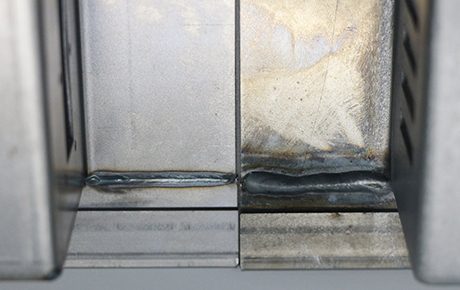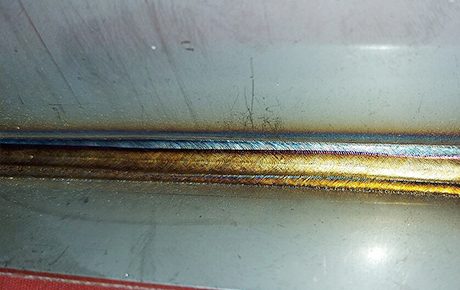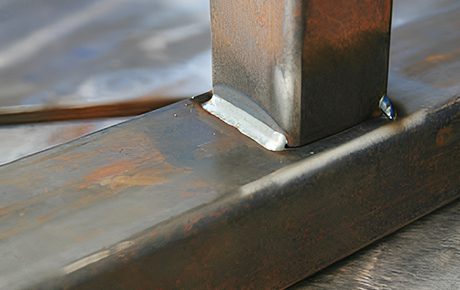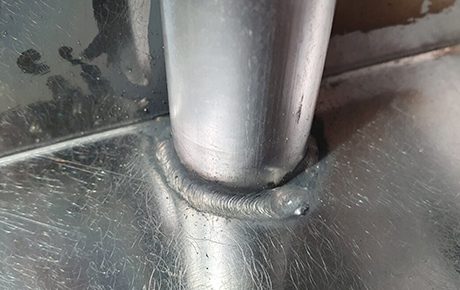FW-T Laser Welding Machine
The FW-T laser welding machine features a 3-in-1 head for welding, cutting, and cleaning, with a dual wire feeder, fiber laser, and a movable design for versatile, high-precision metal processing.
Produces clean, narrow weld seams with minimal distortion, ideal for tight-tolerance applications in many industries.
Achieves strong welds even on thick materials while minimizing heat-affected zones and reducing the risk of warping or cracking.
Operates at high speeds with consistent quality, significantly boosting production efficiency and reducing cycle times in manufacturing.
Generates smooth, clean welds with little to no spatter, reducing the need for grinding, polishing, or rework.
Capable of welding a wide range of metals, including stainless steel, aluminum, with strong joints and excellent structural integrity.
Easily integrates into automated lines, enabling seamless, high-precision welding in advanced manufacturing environments.






Laser welding does not always require filler material, but it depends on the type of joint, material thickness, and application requirements. Unlike traditional welding methods, laser welding can achieve high-strength, precise welds through autogenous (fusion) welding, where the base metals melt and fuse without additional material. However, in certain cases, filler material may be necessary.
Laser welding can be performed with or without filler material, depending on the joint design, material properties, and welding application. For tight-fit, precision welding, no filler is required, while gapped joints, dissimilar metals, or thick materials may benefit from filler material to enhance weld quality and strength.
Thermal deformation is a potential concern in laser welding, but it is significantly lower compared to traditional welding methods such as MIG, TIG, or arc welding. This is because laser welding has a highly focused heat input, leading to minimal thermal distortion. However, factors such as material type, heat buildup, welding speed, and joint design can still influence the level of deformation.
While laser welding significantly reduces thermal deformation compared to conventional welding, thin materials, excessive heat input, and poor fixturing can still cause some warping. By optimizing parameters, using proper clamping, pulsed welding, and cooling techniques, deformation can be minimized, ensuring high-quality, precise welds with minimal distortion.
Laser welding is highly versatile and can be used to create various joint types, depending on material thickness, application requirements, and weld strength needs. Below are the most common types of joints that can be welded using laser technology.
Laser welding supports butt, lap, T-joint, corner, edge, and flange joints, making it ideal for precision fabrication, structural applications, and high-strength welding. Choosing the right joint type depends on material thickness, strength requirements, and welding technique.
We offer a comprehensive warranty policy to ensure reliable performance and long-term support for our laser welding machines. Below is a detailed breakdown of our warranty coverage, including the warranty period, terms and conditions for different components, and how customers can apply for warranty service.
Our laser welding machine has a 3-year warranty on the entire machine, a 2-year warranty on the laser generator, and a 1-year warranty on core components. This structured warranty ensures that customers receive high-quality support and service. To maintain the performance of the machine and extend its life, we recommend regular maintenance and correct operation. If any problems arise, our technical support team can assist with troubleshooting and warranty claims.
Our laser welding machines meet international quality, safety, and regulatory standards, ensuring reliability, compliance, and customer confidence. Below is a detailed overview of the key certifications our machines hold and their significance.
Our laser welding machines are certified to meet international quality and safety standards, including ISO 9001, CE, and FDA certifications. These certifications ensure that our machines are manufactured with strict quality control, meet European safety regulations, and comply with U.S. laser safety requirements. Customers can be assured of high performance, reliability, and legal compliance when purchasing and operating our machines.
On-site technical support is available for laser welding machines, providing customers with hands-on assistance for installation, troubleshooting, training, and maintenance. However, this service comes at an additional cost. The standard service fee is US$200 per day, and customers are also responsible for covering the engineer’s round-trip airfare, board, lodging, and local transportation if required. This ensures that customers receive expert guidance directly at their facility to maximize machine performance and minimize downtime. The process for requesting on-site support involves contacting customer service, providing details of the issue, receiving a cost estimate, and scheduling an engineer visit. While on-site service is a valuable option, customers can also choose remote support, which includes troubleshooting via phone, email, or video calls, as well as access to online training materials and documentation at no additional cost. If in-person assistance is necessary, we are ready to arrange a visit to ensure the machine operates efficiently and reliably.
Our machines are built with robust components and high-precision engineering to ensure long-term durability and consistent welding performance in demanding environments.
We offer intelligent control systems, auto-focus laser heads, and real-time monitoring to deliver fast, accurate, and stable welding results.
Our machines support a wide range of welding methods and materials, from thin sheets to complex assemblies, across multiple industries.
We provide machine configurations tailored to your specific workflow, product design, and production volume for optimal performance and efficiency.
Faster Laser offers professional training, technical support, and fast-response service to ensure seamless operation and minimal downtime.
Our machines combine high-quality performance with competitive pricing, helping businesses maximize productivity while minimizing energy, labor, and material waste.
8 reviews for FW-T Laser Welding Machine
Grant –
New hires master the basics quickly because the touchscreen shows power, speed, and gas as big color bars. When values drift, the screen flashes gentle prompts instead of cryptic codes. This real-time coaching slashes learning curves, letting trainees move from coupons to production parts by their fourth day.
Kai –
Repairing cracked steel dies in-house saves outsourcing days. The welder boots fast, and wobbler control fills gaps wide without extra filler rod. We resume casting the same afternoon, holding production targets even during tool-break emergencies.
Nora –
The tight focus zone keeps polymer housings next to metal inserts from melting. Seam surfaces emerge so smooth we skip passivation baths, reducing chemical use and paperwork. Recipe presets lock settings, ensuring every shift replicates validated parameters required by our ISO13485 protocol without lengthy requalification.
Vivian –
Delicate aluminum armor panels once curled under heat. Laser fusion keeps them flat, so paint layers remain smooth. My studio appreciates the silent operation, allowing collaborative conversations while pieces are welded on a rolling stand.
Miles –
After twelve weeks, the welder hasn’t missed a beat. Thin Stainless steel panels stay straight, so fit-up on assembly jigs is quicker. The graphical menu guides operators step by step, even night-shift interns. Gas flow dropped a quarter and cut overtime requests across the department, pleasing both planners and payroll.
Lila –
Cycle-time studies show a solid thirty-two percent reduction in stainless steel enclosures. Energy meters confirm lower current draw than TIG, cutting utility bills. Gas cylinder deliveries moved from weekly to biweekly, easing dock traffic. Production dashboards now show welding as our top-performing cell, setting a benchmark for future upgrades.
Harper –
Switching to laser removed almost all spatter on galvanized shelves. Beads sit smooth enough to ship without grinding, freeing one employee for higher-value tasks. Cooling fans whisper, making headset communication easier on loud days. The slim torch hose never kinks, and recipe recall lets crews swap alloys in minutes.
Sienna –
We track OEE metrics closely. Since installation, welding availability rose from 85 to 96 percent thanks to shorter maintenance and fewer tip changes. Performance gains fed straight into our ERP, revealing unexpected capacity for another customer line without adding headcount or floorspace.